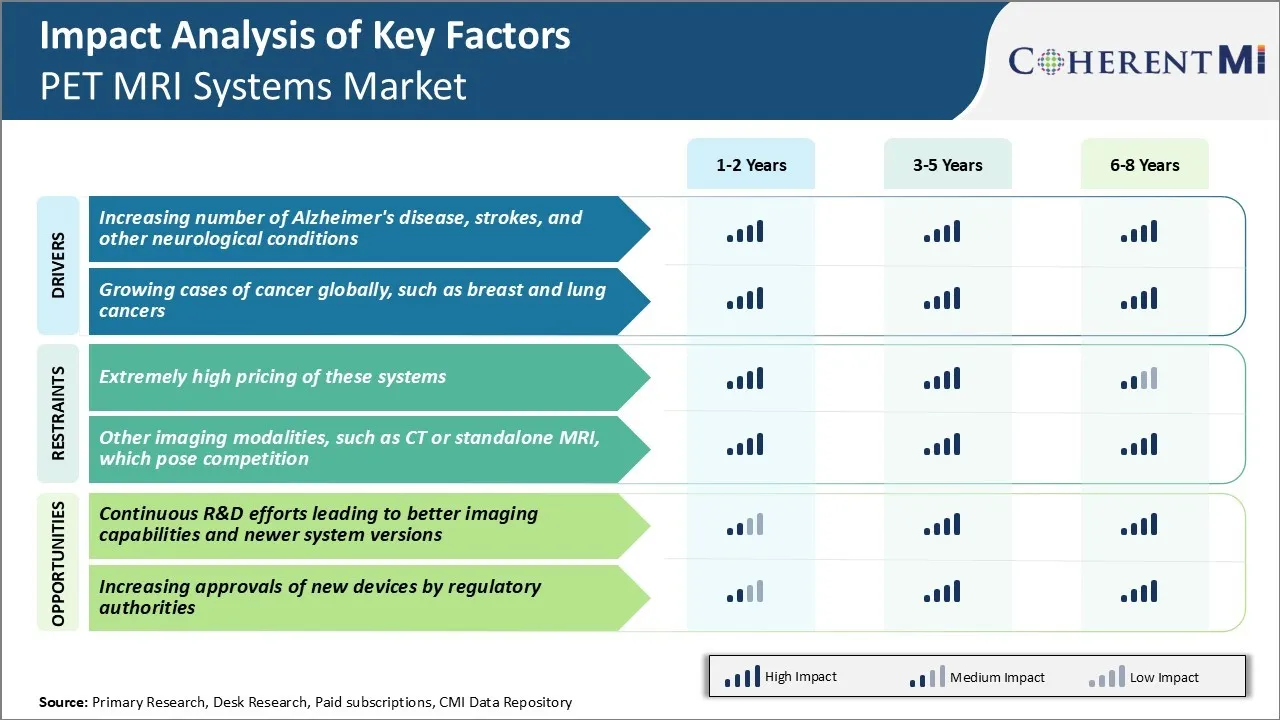PET MRI Systems Market Trends
Market Driver - Increasing Number of Alzheimer's Disease, Strokes, and Other Neurological Conditions
As per estimates, over 50 million people globally suffer from dementia with around 10 million new cases every year. Alzheimer's disease itself is one of the major causes of dementia and its prevalence is expected to triple in the coming years owing to an aging population. PET MRI systems are hugely beneficial in diagnosing such neurological illnesses especially in their early stages. The multi-modality approach allows physicians to get functional as well as anatomical details of the brain.
PET MRI systems are emerging as an important tool in this aspect. Their non-invasive whole body scanning abilities help map intricate disease pathways and gain a systems level understanding of the illness. This fosters more personalized care approaches.
Several clinical trials are ongoing to evaluate PET MRI for conditions like epilepsy, Parkinson's, Huntington's, etc. Its role in improving early detection rates as well as aiding drug development is being actively explored. The growing mental healthcare needs especially in developing countries will further propel demand.
Overall, with neurological conditions posing a significant economic threat, PET MRI systems offer a feasible solution, contributing to the growth of the PET MRI systems market.
Market Driver – Cancer Burden Driving PET MRI Adoption
Rising worldwide incidence of cancer has made it one of the leading causes of mortality. As per estimates, around 19 million new cancer cases and 10 million cancer deaths occurred in 2020 globally.
PET MRI systems are increasingly utilized for cancer staging, treatment monitoring and drug development. The molecular diagnostic abilities of PET finds application right from initial staging to determine tumor involvement and metastases. Simultaneously, high resolution anatomical MRI aids in precise localization and surgical planning.
Cancer types where PET MRI is proving especially valuable include breast cancer and lung cancer. As per some studies, PET MRI may obviate unnecessary biopsies in breast cancer by more accurate lesion characterization compared to conventional imaging.
It provides a radiation-free whole-body assessment with improved specificity over standalone modalities. With newer targeted therapies and immunotherapies entering the market, non-invasive functional assessment of therapeutic efficacy is crucial.
Overall, multi-parametric imaging holds potential for individualizing cancer care. Role of PET MRI in oncology management continues to expand through ongoing research. Thereby, its adoption rates for leading cancer types are expected to rise in the coming years.

Market Challenge - Extremely High Pricing of PET MRI Systems
One of the major challenges faced by the PET MRI systems market is the extremely high pricing of these systems. Integrating these complex imaging modalities into a single system leads to a very high manufacturing cost. On average, a PET MRI system can cost between $4-6 million which is significantly higher than conventional PET or MRI scanners individually. This steep pricing puts the technology out of reach for many hospitals and imaging centers, especially those in developing regions.
The high capital requirement also results in a longer return on investment timeline. While the dual diagnostic capabilities provide valuable clinical advantages, the exorbitant price tag poses a serious barrier for widespread adoption of PET MRI technology. Manufacturers will need to focus on innovative design approaches and use of newer materials to decrease production costs in order to make these systems more affordable for the mass market.
Market Opportunity - Continuous R&D Efforts Leading to Better Imaging Capabilities
One key opportunity for the PET MRI Systems market lies in continuous research and development efforts that are leading to better imaging capabilities and newer system versions. PET MRI is an emerging molecular imaging technology that combines the functional imaging power of PET with the high-resolution anatomical imaging of MRI.
Ongoing advancements in hardware design, computing technology as well as image reconstruction algorithms are helping to overcome initial challenges and improve the diagnostic performance of PET MRI scanners. This includes development of newer generation PET and MRI components with enhanced sensitivity and resolution.
In addition, system manufacturers are launching improved hybrid configurations with features like time-of-flight PET detection. Continuous innovation is also expanding clinical applications from brain imaging to whole-body oncological diagnostics.
R&D investments are thus enhancing the value proposition of PET MRI over time compared to separate PET and MRI exams. This will help drive increased adoption rates as new version launches deliver improved clinical utility.